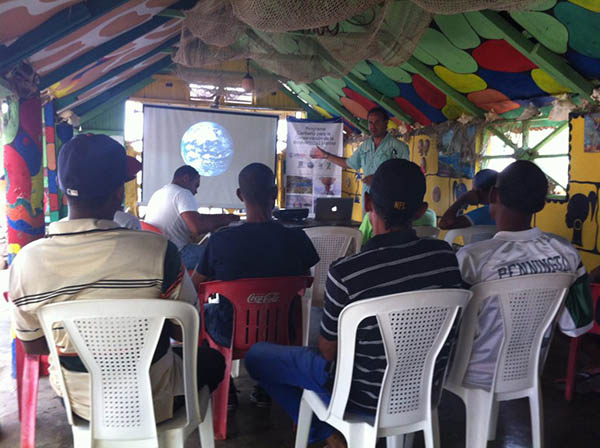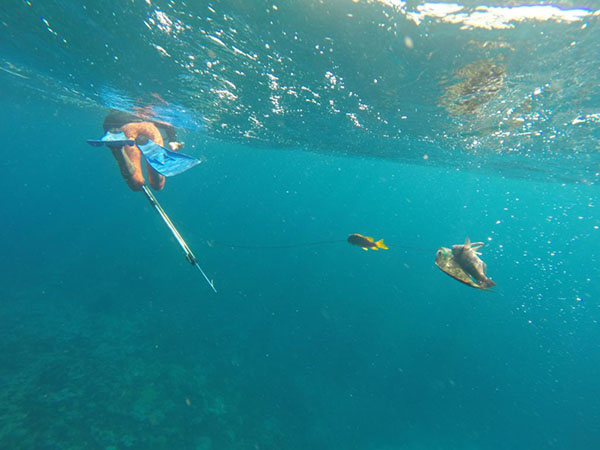During the week of Easter, the beaches of the Dominican Republic were converted into billboards for the campaign to stop the consumption of parrotfish. Pictures taken from drones showed brilliant blues of the ocean bordered by the characteristic white sands of beaches throughout the country. Spelled out on the sand were calls for help. The messages, “Save me, don’t eat parrotfish,” “If you eat parrotfish, I disappear,” “If you eat parrotfish, you eat away my sand,” and “SOS: parrotfish,” were each followed by the hashtag #lasplayashablan: the beaches speak.
Images of the nation’s beaches calling out for help flooded social media, a campaign sponsored by one of the Dominican Republic’s largest supermarkets and supported by the Ministry of Environment. In these representations – and in broader social and political initiatives – parrotfish, sand, beaches, and human consumers are entangled in ways that are either environmentally responsible or irresponsible. In this post, I want to move from the aerial perspective of drones and social media to an aquatic one, where fishermen come eye-to-eye with the fish that conservation NGO’s have dubbed “the laborers of the sand factories” of the Dominican Republic. In this process, I analyze how charismatic minifauna such as parrotfish are made to play a part in the process of moralizing of environmental relations.
Parrotfish are conventionally beautiful fauna. Bright greens, yellows, and blues decorate their scaled bodies, with different species hosting different frequencies of the rainbow. Their vivid colors and down-curved beaked mouth recall their namesake, the parrot, so much so that you almost expect them to break out in raucous mimicry of human language underwater. A curious and unthreatened parrotfish will swim towards a diver, pausing to ‘stand up,’ – float vertically instead of horizontally – sideways, giving you the lookover, and providing a perfect opportunity to launch your spear through its body. As I learned to spearfish as a part of my dissertation research among fishermen on the northern Dominican coast, parrotfish were the first species that I learned to fish, easy as they were to catch, and abundant in the region’s subaquatic. “All you have to do is lay down on the seafloor and they come right at you,” my interlocutors instructed. But these colorful fish followed my interlocutors and I out of the water, they were a constant presence not only as we dove reef labyrinths, but also in the growing chorus of parrotfish protectors made up of conservation NGO’s, the Ministry of Environment, and concerned bystanders.

Fishermen attend a meeting held by ReefCheck discussing parrotfish and their environmental value (all photos courtesy of the author).
Parrotfish, as this chorus insisted, poop sand. Without sand, the beautiful white beaches of the nation’s tourist brochures would disappear, and without tourism, the economy would suffer. A year after I fist learned to spearfish, parrotfish were legally put under protection from fishing. With this action, the discourse of tourism expanded to include the ecological (read scientific) value of this species. Informational pamphlets and workshops pointed out that parrotfish were grazers, keeping the reefs healthy by eating away at algae and dead bits of coral. I sat in a series of meetings, workshops, and informational sessions as experts in biology explained the parrotfish’s digestive process to fishermen whose quotidian labor involved the careful gutting of parrotfish, including the removal and killing intestinal parasites so that they wouldn’t harm future fish. Fishermen interpreted these meetings and talks as condescending, hierarchical maneuvers meant to comply with bureaucratic obligations, rather than reflections of any ecological reality.
The questions I want to call into anthropological pondering here are twofold. How are parrotfish made to speak on behalf of conservation in the Caribbean? And what kinds of human-nonhuman entanglements are obscured in the process of drawing extraordinary attention to one species of fish? The story of parrotfish in the Dominican Republic is one in a broader process of moralizing environmental relations. Yet this story and many others of today’s charismatic minifauna are representative of how human-nonhuman entanglements are created and managed. By asking who and what are allowed to speak, allotted charisma in today’s conservation regimes, I also want to inspire reflections on which nonhumans have been given a role in Science and Technology Studies, and to what ends.
To Whom the Parrotfish Speaks
Parrotfish are what is known as a third class fish. In the fish shops frequented by the fishermen I work with, parrotfish is considered low quality, thus sold for cheaper than the grouper, snapper, barracuda, mackerel, and jack also caught on the end of a spear. As such, parrotfish is the protein of the poor, one of the fish affordable to fishermen and their families. Tourists and foreigners living in the Dominican Republic often tell one another to be careful what they order in restaurants, since it’s known that grouper on the menu – an expensive and first class fish – often appears on the plate as a parrotfish fillet. In the days before Good Friday, when it is customary for Dominicans to eat fish in lieu of meat, the messages on the beaches urging people not to each parrotfish were not directed at tourists or those ordering grouper in restaurants catering to foreigners. When the beaches asked the nation not to eat parrotfish for the sake of sand, they were not really asking the entire nation. Rather, the environmental theatre that played out was meant to create a political and moral environment with easily distinguishable heroes and villains. Those most likely to eat parrotfish are those who can’t afford to buy first and second-class fish. Fishermen, thus, appear as doubly to blame in such a scheme.
When the parrotfish comes to represent the ecological well-being of the nation, its entanglements with humans come under scrutiny. Depicting this species as the poster child for ocean conservation also obscures the human-fish entanglements that happen on levels not of interest to science. Fishermen, whose daily encounters with parrotfish offer them extreme insights as to the biology, behavior, quantity, and personalities of these fishes, are portrayed as environmental villains with no sense of the future damage their actions beget. And parrotfish, for that matter, are portrayed as innocent (and beautiful) laborers in a threatened ecological system. The only entanglements that matter in such a regime of moralized environmental relations are those where fishermen kill parrotfish (bad) and where parrotfish, trying to keep the reefs clean and healthy, make sand for tourist beaches (good). As the voices of ocean conservation grow louder and garner more funding, anthropologists studying the contexts and subjects of human-nonhuman entanglements must attend to how moral values get attached to such entanglements. As parrotfish are singled out as the poster child for conservation in the Dominican Republic’s aquatic territory, classist and aesthetic undertones also fill the messages on the beaches.
Literate Fish
“The parrotfish are sticking out their tongue at me,” Ramon sighed as he climbed back into the outboard-motored boat anchored in the shallow reef of a cay where we were fishing. The bigger the parrotfish, the more tíguere, or cunning it is when faced with a spear fisherman, keeping a distance just longer than the reach of a spear. Ramon described to his colleagues how the usually skittish parrotfish of a good size seemed to have been informed of their legal protection, taunting Ramon as they uncharacteristically swam within reach of his spear. His colleague, Manuel, laughed describing his identical experience. “The fish here know how to read and write,” the fishermen agreed as they recalled parrotfish faster than airplanes, huge grouper who could disappear in a tiny cave, and one particular barracuda that had been eluding fishermen for years while snatching smaller fish off of divers’ catch lines. Fishermen are the first to recognize the charisma of fish and other marine nonhumans, yet they remain the de facto villains in the narratives posited by internationally funded and tourism-inclined conservation regimes. What is lost as the parrotfish is made to speak for the agendas of conservation regimes is the texture of human-nonhuman entanglements as they play out in the day to day.

Fish in tow. Image by author.
Fish and other marine animals inspire us, we feel affinities with them, and we desire to understand them. In the midst of these affective intentions, fish and their maritime colleagues are made to speak for science and technology, including the anthropology of science and technology. Many of us in STS study ‘experts,’ and like the experts we study, our theories are often built on the backs of bivalves (Callon 1987’s scallops), or held together by metaphors of fishermen (Latour 2007’s networks). What happens when we ask ourselves how some fish have come to possess charisma in the anthropocene as we know it, and what may be obscured by this charisma? Tangled up in the politics and prejudices of culture, charismatic nonhumans more often reflect our own values, hopes, and morals with regard to relations rather than the knowledge born from entanglements in which they are already involved. If we are to take seriously the other-than-human in anthropology, how can we retain a self-awareness of how we too use fish and other nonhumans in order to further theories, build epistemologies, or to parrot human politics?
References
Callon, Michel
1987 Some Elements of a Sociology of Translation: Domestication of the Scallops and the Fishermen of St. Brieuc Bay. In Power, Action, and Belief: A New Sociology of Knowledge? J. Law, ed. Pp. 67-83. London: Routledge.
Latour, Bruno
2007 Reassembling the Social: An Introduction to Actor-Network-Theory. Oxford: Oxford University Press.
